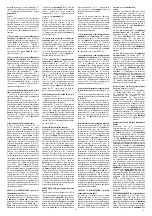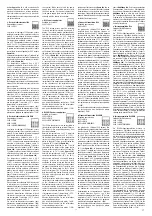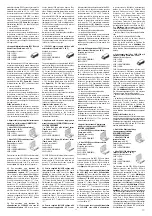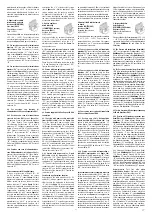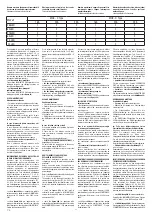
16
16
reperibile sul mercato, il cavo multipolare a 12
conduttori (11 conduttori neri numerati da 1 a
11 + 1 conduttore di terra giallo-verde, vedere
paragrafo 2.2
).
Distanza:
tra 0 e 70 metri: utilizzare cavo con conduttori
da 1,5mm2; tra 70 e 100 metri: utilizzare cavo
con conduttori da 2,5mm2. Il pressacavo M32
permette l’ingresso di un cavo con diametro
esterno massimo ≤ 22,4mm. Per accedere alla
cassetta di derivazione, agire sulle 4 viti “V”
in acciaio inox (vedere
figura 1c
) ed aprire il
coperchio.
2.1 Per versione con 1 cavo di collegamento
multipolare 10 conduttori “C8”
(soluzione
consigliata) Far passare il cavo multipolare “C8”
(vedere
figura 21a
) attraverso il pressacavo
“G1” e sotto il serracavo “S1”. Collegare i
conduttori del cavo multipolare “C8” numerati
da 1 a 10 ai rispettivi poli numerati da 1 a 10
del morsetto “M1” (vedere
figure 30 - 31a
) e
serrare il serracavo “S1”.
2.2 Per versione con 1 cavo di collegamento
multipolare 12 conduttori “C11”
All’interno
della cassetta di derivazione a bordo apparecchio
tagliare ed isolare il conduttore n.° 11 del cavo
“C11” ed il conduttore di terra giallo-verde
(vedere
figura 31b
). La medesima operazione
andrà eseguita anche dall’ altro capo del cavo.
Far passare il cavo multipolare “C11” (vedere
figura 21b
) attraverso il pressacavo “G1” e
sotto il serracavo “S1”. Collegare i conduttori
del cavo multipolare “C11” numerati da 1 a 10
ai rispettivi poli numerati da 1 a 10 del morsetto
“M1” (vedere
figure 30 e 31b
) e serrare il
serracavo “S1”. Utilizzare esclusivamente i
conduttori neri numerati da 1 a 10.
è necessario collegare l’apparecchio a terra
come segue
(valido per i capitoli 2.1 e 2.2):
• cavo di terra unipolare separato con sezione
minima di 6mm2 collegato alla morsettiera della
cassetta di derivazione.
Allentare la ghiera “Y” del pressacavo “G3” ed
estrarre il relativo tappo. Per cavi con diametro ≤
8mm utilizzare apposito gommino ridotto fornito
in dotazione nel sacchetto presente all’interno
della scatola dell’apparecchio (vedere
figura
42
). Far passare il cavo di Terra “C5” (vedere
figura
18
) attraverso il pressacavo “G3” e sotto
il serracavo “S3”. Collegare il conduttore al polo
di Terra del morsetto “M1” (vedere
figure
30
) e
serrare il serracavo “S3”.
Parte comune per tutti i capitoli sopra
In base al pressacavo utilizzato (G1, G2
e/o G3): verificare il serraggio, con chiave
inglese, del corpo “X” (vedere
figura 13
) del/i
pressacavo/i applicando un momento torcente
di 4Nm; serrare con cura e a fondo, con chiave
inglese, la ghiera “Y” (vedere
figura 13
) del/i
pressacavo/i applicando un momento torcente
di 3.5Nm. Una volta collegato elettricamente
l’apparecchio, richiudere il coperchio della
cassetta di derivazione serrando le 4 viti V”
(vedere
figura
1c
) in acciaio inox applicando un
momento torcente di 5.2Nm assicurandosi che
la guarnizione sia perfettamente nella sua sede.
Verificare che il coperchio sia perfettamente
in battuta sulla cassetta di derivazione Nella
scatola cablaggio sono presenti 4 scaricatori DC
che avranno i contatti remoti normalmente chiusi
collegati fra loro in serie (questi surge protection
device portano la resistenza alla fulminazione
fino a 12kV). Vedere
figura 35
. Pertanto,
vengono utilizzati n°2 conduttori facenti parte
del cavo di alimentazione e collegandosi ai poli
1 e 2 (vedere f
igure 31a
,
31b, 35
) è possibile,
tramite tester, verificare la continuità del
circuito (presente = SPD OK; assente = SPD
GUASTI). Una volta definito in quale proiettore
si è verificata l’apertura del circuito si opera in
manutenzione straordinaria la sostituzione della
cartuccia del dispositivo guasto (spia rossa). I 4
scaricatori DC sono presenti solo nella soluzione
con cablaggio separato.
GRUPPI DI ALIMENTAZIONE (piastre di
alimentazione e box FAEL)
Le distanze da mantenere tra una piastra di
alimentazione IP66 (o IP20) e l’altra sono indicate
in
figura 33a
(o in
figura 33b
). Le distanze da
mantenere tra un box di alimentazione/driver
IP66 e l’altro sono indicate in
figura
33c
o in
figura 33d
. È necessaria una corrispondenza
biunivoca tra piastra armadio/box ed il proiettore
conductors (see
paragraph 2.1
) or, use the
version more readily available on the market,
with 12 conductors (11 black conductors
numbered from 1 to 11 + 1 yellow-green earth
conductor, see
paragraph 2.2
).
Distance:
between 0 and 70 metres: use cables with
1.5mm2 conductors; between 70 and 100
meters: use cables with 2.5mm2 conductors.
The M32 cable gland allows the insertion of a
cable with the maximum outside diameter ≤
22.4mm. To access the cable box, act on the 4
“V” stainless steel screws (check the
figure 1c
)
and open the cover.
2.1 Version with 1 multi-pole 10-conductor
connecting cable “C8
” (recommended) Pass
the multi-pole cable “C8” (check the
figure
21a
) through the cable gland “G1” and beneath
the cable clamp “S1”. Connect the conductors
of the multi-pole cable “C8” numbered from 1
to 10 to the related poles numbered from 1 to
10 of the terminal “M1” (check the
figures 30 -
31a
) and tighten the cable clamp “S1”.
2.2 For version with 1 multi-conductor
cable with 12 conductors “C11”
Cut and
insulate conductor no. 11 of the “C11” cable
and the yellow-green earth conductor inside
the junction box installed on the luminaire
(see
figure 31b
). The same operation shall be
performed on the other end of the cable. Thread
the “C11” multi-conductor cable (see
figure
21b
) through the “G1” cable gland and under
the “S1” cable clamp. Connect the conductors
of the “C11” multi-conductor cable numbered
from 1 to 10 to the corresponding connectors
numbered from 1 to 10 available on the “M1”
terminal strip (see
figures 30 and 31b
) and
tighten the “S1” cable clamp. Use only the
black conductors numbered from 1 to 10.
Earth the luminaire as described below
(valid
for chapters 2.1 and 2.2):
• separate single-conductor earth cable with
a minimum section of 6mm2 connected to the
terminal board of the junction box.
Loosen ring nut “Y” of the “G3” cable gland and
remove the cap. For cables having diameter ≤
8mm, use a suitable grommet supplied in
the bag fitted inside the appliance housing
(check the
figure
42
). Pass the Ground cable
“C5” (check the
figure
18
) through the cable
gland “G3” and beneath the cable clamp “S3”.
Connect the conductor to the Ground pole of the
terminal “M1” (check the
figure 30
) and tighten
the cable clamp “S3”.
Part shared by all previous chapters
Depending on the cable gland used (G1, G2
and/or G3): using a spanner, apply a torque
4Nm to check the tightening of the housing
“X” (check the
figure
13
); use a spanner and
apply a torque of 3.5Nm to tighten carefully and
completely the ring nut “Y” (check the
figure
13
). Once the appliance is connected, close
back the cables box cover and tighten the 4
“V” stainless steel screws (check
figure
1c
) by
applying 5.2Nm torque, making sure the gasket
is perfectly fit. Ensure the cover is perfectly
abutted to the cables box The cables box
features 4 DC surge arresters having normally
closed remote contacts connected in series (the
surge protection device grows the resistance
to lightning strikes up to 12kV). Check the
figure
35
. As a consequence, there are used
n.° 2 conductors of the power supply cable; by
getting connected to the poles 1 and 2 (check
the
figures 31a, 31b, 35
) it is possible to check
using a tester the circuit continuity (continuity
= SPD OK; no continuity = SPD FAULTY). Once
the projector on which the circuit opened has
been identified, it is possible to perform the
extraordinary maintenance and replace the
cartridge of the faulty device (red light). The
4 DC surge arresters are only provided for the
versions with separated cables.
POWER UNITS (FAEL power supply plates and
boxes)
The distances to be kept between an IP66 (or
IP20) power supply plate and the next are given
in the
figure 33a
(or
figure 33b
). The distances
to be kept between an IP66 power box /driver
and the next are given in
figure 33c
or in
figure
33d.
It is required a two-way correspondence
between the cabinet plate/box and the projector
(check the
figure 34a
,
b
,
c
or
d
depending on
noirs numérotés de 1 à 11 + 1 conducteur de
terre jaune-vert, voir
paragraphe 2.2
) plus
facilement trouvable en commerce.
Distance:
entre 0 et 70 mètres: utiliser un câble avec
des conducteurs de 1,5mm2; entre 70 et 100
mètres: utiliser un câble avec des conducteurs de
2,5mm2; Le presse-câbles M32 permet l’entrée
d’un câble de diamètre extérieur maximum ≤
22,4mm. Pour accéder à la boîte de dérivation,
desserrer les 4 vis “V” en acier inox (voir
figure
1c
) puis ouvrir le couvercle.
2.1 Pour version avec 1 câble de branchement
multipolaire 10 conducteurs C8”
(solution
conseillée) Faire passer le câble multipolaire
“C8” (voir
figure 21a
) à travers le presse-câble
“G1” et sous le serre-câbles “S1”. Brancher
les conducteurs du câble multipolaire “C8”
numérotés de 1 à 10 respectivement aux pôles
numérotés de 1 à 10 de la borne “M1” (voir
figure
30
-
31a
) puis serrer le serre-câbles “S1”.
2.2 Pour version avec 1 câble de branchement
multipolaire 12 conducteurs “C11”
À l’intérieur
de la boite de dérivation, à bord de l’appareil,
couper et isoler le conducteur n.° 11 du câble
“C11” et le conducteur de terre jaune-vert
(voir
figure
31b
). Il faudra effectuer la même
opération sur l’autre extrémité du câble. Faire
passer le câble multipolaire “C11” (voir
figure
21b
) à travers le presse-câble “G1” et sous le
serre-câbles “S1”. Brancher les conducteurs du
câble multipolaire “C11” numérotés de 1 à 10
respectivement aux pôles numérotés de 1 à 10 de
la borne “M1” (voir
figure
30
et
31b
) puis serrer
le serre-câbles “S1”. Utiliser exclusivement les
conducteurs noirs numérotés de 1 à 10.
Il est nécessaire de brancher l’appareil à terre
de cette façon
(valable pour les chapitres 2.1 et
2.2):
• câble de terre unipolaire séparé avec section
minimum de 6mm² branché au bornier de la boite
de dérivation.
Desserrer la bague “Y” du presse-câbles “G3”
et en extraire le bouchon. Pour les câbles de
diamètre ≤ 8mm, utiliser le petit tampon fourni en
dotation dans le sachet présent à l’intérieur de la
boite de l’appareil (voir
figure
42
). Faire passer le
câble de Terre “C5” (voir
figure
18
) à travers le
presse-câble “G3” et sous le serre-câbles “S3”.
Brancher le conducteur au pôle de Terre de la
borne “M1” (voir
figure
30
) et serrer le serre-
câbles “S3”
Partie commune à tous les chapitres ci-dessus
Selon le presse-câbles utilisé (G1, G2 et/ou G3):
Vérifier le serrage du corps “X” (voir
figure
13
)
du/des serre-câbles avec une clé anglaise,
en appliquant un moment de torsion de 4Nm.
Toujours avec la clé anglaise, serrer bien à fond
le collier de serrage “Y” (voir
figure
13
) du/
des serre-câbles en appliquant un moment de
torsion de 3.5Nm. Une fois l’appareil branché
électriquement, refermer le couvercle de la
boite de dérivation en serrant les 4 vis V” en
acier inox (voir
figure
1c
) en appliquant un
moment de torsion de 5.2Nm tout en contrôlant
que la garniture loge parfaitement dans son
emplacement. Vérifier que le couvercle est
parfaitement en butée sur la boite de dérivation 4
éclateurs DC se trouvent dans la boite de câblage
avec, normalement, des contacts à distance
fermés connectés entre eux, en série (ces “surge
protection device” permettent une résistance aux
coups de foudre jusqu’à 12kV). Voir
figure 35
. Par
conséquent, on utilise n° 2 conducteurs faisant
partie du câble d’alimentation et en se connectant
aux pôles 1 et 2 (voir
figures
31a
,
31b
,
35
), il
est possible, à l’aide d’un tester, de vérifier la
continuité du circuit (présent = SPD OK; absent =
SPD PANNES). Une fois défini dans quel projecteur
s’est vérifiée l’ouverture du circuit, on intervient
en réparation extraordinaire afin de remplacer la
cartouche du dispositif en panne (témoin rouge).
Les 4 éclateurs DC ne sont présents que dans la
solution avec câblage séparé.
GROUPES D’ALIMENTATION (plaques
d’alimentation et box FAEL)
Les distances à maintenir entre une plaque
d’alimentation IP66 (ou IP20) et l’autre sont
indiquées en figure 33a (ou en
figure 33b
). Les
distances à maintenir entre un box d’alimentation/
driver IP66 et l’autre sont indiquées en
figure
33c
ou en
figure
33d
. Une correspondance
biunivoque entre plaque armoire/box et le
Erdungsleiter, siehe
Abschnitt 2.2
).
Abstand:
zwischen 0 und 70 Metern: Kabel mit 1,5 mm2
Leitern verwenden; zwischen 70 und 100
Metern: Kabel mit 2,5 mm2 Leitern verwenden.
Die M32-Kabeldurchführung ermöglicht die
Einführung eines Kabels mit einem maximalen
Außendurchmesser von ≤ 22,4mm. Um auf den
Verteilerkasten zuzugreifen, drehen Sie die 4
Edelstahlschrauben “V” (siehe
Abbildung 1c
)
und öffnen Sie die Abdeckung.
2.1 Für die Version mit 1 mehrpoligen
Anschlusskabel mit 10 Leitern „C8”
(empfohlene Lösung) Das mehrpolige Kabel
„C8” (siehe
Abbildung
21a
) durch die
Kabelverschraubung “G1” und unter dem
Kabelbaum “S1” durchführen. Die Leiter des
mehrpoligen Kabels „C8” nummeriert von 1 bis
10 an die entsprechenden Pole nummeriert von
1 bis 10 der Klemme “M1” (siehe
Abbildungen
30
-
31a
) anschließen und den Kabelbaum „S1”
anziehen.
2.2 Für die Version mit 1 mehrpoligen
Anschlusskabel 12 Leiter „C11”
Im
Verteilerkasten am Gerät den Leiter Nr. 11 des
Kabels “C11” und den gelb-grüner Erdungsleiter,
schneiden und isolieren (siehe
Abbildung
31b
). Den gleichen Vorgang auch vom anderen
Ende des Kabels durchführen. Das mehrpolige
Kabel “C11” (siehe
Abbildung
21b
) durch
die Kabelverschraubung “G1” und unter dem
Kabelbaum “S1” durchführen. Die Leiter des
mehrpoligen Kabels “C11” nummeriert von 1 bis
10 an die entsprechenden Pole nummeriert von
1 bis 10 der Klemme “M1” (siehe
Abbildungen
30
und
31b
) anschließen und den Kabelbaum
“S1” anziehen. Ausschließlich schwarze Leiter
nummeriert von 1 bis 10 verwenden.
Das Gerät muss wie folgt geerdet werden
(gültig für die Kapitel 2.1 und 2.2):
• Einpoliges getrenntes Erdungskabel
mit Mindestquerschnitt von 6mm2 an
die Klemmenleiste des Verteilerkastens
angeschlossen. Die Schraube “Y” der
Kabelverschraubung “G3” lösen und den
entsprechenden Verschluss herausziehen.
Für Kabel mit Durchmesser ≤ 8mm geeignete
kleine Gummidichtungen verwenden, die im
Beutel im Inneren der Schachtel des Gerätes
mitgeliefert werden (siehe
Abbildung
42
). Das
Erdungskabel “C5” (siehe
Abbildung
18
) durch
die Kabelverschraubung “G3” und unter dem
Kabelbaum “S3” durchführen. Den Leiter an den
Erdungspol der Klemme “M1” (siehe
Abbildung
30
) anschließen und den Kabelbaum “S3”
anziehen.
Gemeinsamer Teil für alle oben aufgeführten
Kapitel
Basierend auf der verwendeten
Kabeldurchführung (G1, G2 und/oder G3):
Überprüfen Sie, mit einem Drehmomentschlüssel,
den Anzug des Gehäuses “X” (siehe
Abbildung
13
) der Kabeldurchführung/en mit einem
Drehmoment von 4Nm. Ziehen Sie die Schraube
“Y” (siehe
Abbildung
13
) der Kabeldurchführung/
en mit Drehmoment 3.5Nm vorsichtig an. Wenn
das Gerät elektrisch angeschlossen ist, die
Abdeckung des Verteilerkastens wieder schließen
indem die 4 Schrauben „V“ (siehe
Abbildung
1c
) aus Edelstahl mit einem Drehmoment von
5,2 Nm angezogen werden, um sicherzustellen,
dass die Dichtung perfekt sitzt. Stellen Sie sicher,
dass die Abdeckung perfekt am Verteilerkasten
anliegt In der Verdrahtungsbox befinden sich
4 DC-Trennschalter, welche normalerweise
die ferngesteuerten Kontakte geschlossen
und untereinander in Reihe angeschlossen
haben (diese Surge Protection Device sorgt für
Schutz gegen Blitzeinschlag bis zu 12kV). Siehe
Abbildung 35
. Daher werden 2 Leiter verwendet,
die Teil des Stromkabels bilden und an die Pole
1 und 2 (siehe
Abbildungen
31a
,
31b
,
35
)
angeschlossen werden. Somit kann durch Tester
die Kontinuität des Schaltkreis überprüft werden
(vorhanden = SPD OK; nicht vorhanden = SPD
DEFEKT). Sobald festgelegt ist, in welchem
Scheinwerfer die Öffnung der Schaltung
aufgetreten ist, wird die Patrone des defekten
Geräts (rotes Licht) durch außerordentliche
Wartung ersetzt. Die 4 DC-Trennschalter sind
nur in der Lösung mit separater Verdrahtung
vorhanden.
VERSORGUNGSEINHEIT (Versorgungsplatten
und Box FAEL)
Die zwischen einer
Versorgungsplatte IP66 (oder IP20) und
der anderen einzuhaltenden Abstände sind
angegeben in Abbildung 33a (oder in
Abbildung
33b
). Die zwischen einer Versorgungsbox/
Treiber IP66 und der anderen einzuhaltenden
Abstände sind angegeben in
Abbildung
33c
19
Содержание 514084501
Страница 1: ...Glamox O92 O93 SYM User manual ...
Страница 6: ...3 3 6 ...
Страница 7: ...4 7 ...
Страница 11: ...8 11 ...
Страница 12: ...9 12 ...
Страница 15: ...12 15 ...
Страница 17: ...14 17 ...
Страница 20: ...17 20 ...
Страница 24: ...21 24 ...
Страница 26: ...23 26 ...
Страница 29: ...26 29 ...
Страница 30: ...27 30 ...
Страница 32: ...29 32 ...
Страница 33: ...30 33 ...
Страница 34: ...31 34 ...
Страница 35: ...35 ...
Страница 36: ...36 ...
Страница 37: ...34 37 ...
Страница 39: ...35 Note 39 ...















